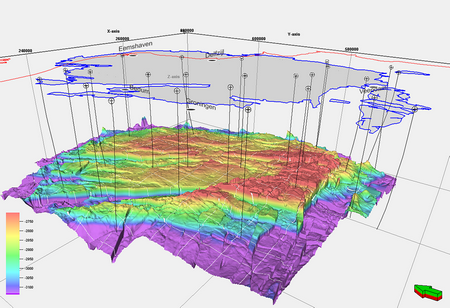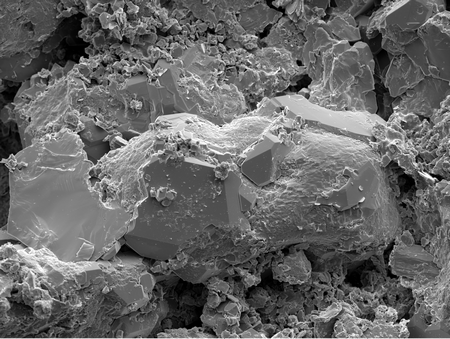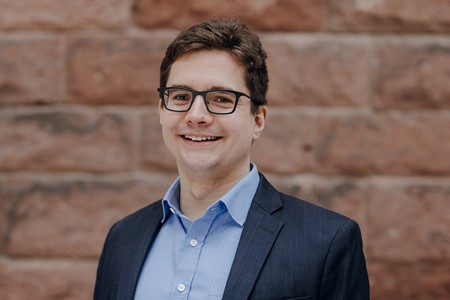How to use the rocks beneath Groningen

Everyone living in or near the Dutch province of Groningen knows about the subsidence and earthquakes that are caused by the gas extraction. How this happens exactly, however, is complicated. Johannes Miocic, Assistant Professor of Geo Energy, is studying the rocks from which the gas is extracted. This should provide more information on what to expect – and how to make better use of those rocks. Storing hydrogen could be one option.
Johannes Miocic studied Geology and Earth Sciences in Germany, where he conducted research on sandstone from Dutch offshore gas fields, and obtained his PhD at the University of Edinburgh (Scotland), with a thesis on carbon dioxide storage. Almost a year ago, he started his position at the University of Groningen. His work is funded by the DeepNL research programme, created by the Dutch Research Council NWO ‘to improve the fundamental understanding of the dynamics of the deep subsurface under the influence of human interventions’.

Subsidence
Miocic: ‘I have always been interested in processes in sandstones. ‘The sandstone rocks that I studied in Germany were of the same type as those in the Slochteren gas field,’ he explains. ‘I am interested in finding out how the composition of these rocks changes across a gas field and between fields.’ He specifically looks at mineral depositions in the rocks, which determine, for example, their mechanical behaviour and the size of the pores in the sandstone. More knowledge about these rocks will allow a more precise prediction of subsidence in and around the gas fields.
‘Subsidence is caused by the removal of gas, which reduces the pressure. This will also cause a flow of water from the surrounding areas, which then may experience some subsidence as well. Not as dramatic as over the Slochteren field, but processes like this will continue for decades.’ Miocic will study cores from over 400 wells that the gas company NAM has drilled over the past 60 years. ‘We will make very thin slices of around 30 micrometres, and determine the mineral content.’ This is primarily done by eye; however, Miocic and his PhD students will use additional techniques, such as electron microscopy and X-ray diffraction.

Ancient desert
From these detailed investigations of rocks from the wells, he will have to extrapolate the geology of the entire gas field. ‘It will be quite challenging. To do this, we combine our findings with existing 3D models of the geology.’ Sedimentology plays a big role in determining how the rocks were formed. The sandstone was formed in an ancient desert. ‘To the north of the current province of Groningen there were big salt lakes, while to the south, there were mountains. The mountains eroded and, by rivers that would flow once or twice each year, the material was transported north into a very flat area. There, the deposited material was reworked by desert dunes. So, we have to find out which rocks originated from where.’
Apart from composition, Miocic will also test the strength of the rocks. This is done in a geology laboratory at Utrecht University. The results will be combined with other, more theoretical studies from the DeepNL programme. ‘This should give us a clearer picture of what exactly is happening in Groningen.’
Carbon storage
As the pressure drop causes so many problems, some have suggested countering these by injecting gas or water into the emptied fields. ‘Using the fields for storage of captured carbon dioxide is a theoretical possibility,’ says Miocic. ‘However, this probably would not go down well with the inhabitants of the area. Besides, more than 400 extraction wells means an equal number of potential leaks. Carbon dioxide can be very aggressive with the cement that was used to block old wells.’ Injecting water would be safer but would require huge amounts, which is unrealistic.

Microorganisms
Another use for empty gas fields could be storage of hydrogen. ‘This has been hyped up a bit, but it is a useful way of storing energy to compensate for the intermittent supply of green energy from solar and wind.’ In principle, hydrogen could be stored safely in empty gas fields or in salt caverns. ‘In the south-east of the province of Groningen, these caverns are available where salt has been mined. Gasunie is currently developing a hydrogen storage facility there.’ However, Miocic only knows of four locations worldwide where hydrogen is stored underground.
There is a specific problem with hydrogen storage – or it may be an opportunity: ‘Microbes underground eat hydrogen; they use it as a source of energy.’ This will cause some losses during storage and may clog up the pores in the sandstone, making it impossible to retrieve the stored gas. However, microorganisms can also combine hydrogen and carbon dioxide to produce methane. ‘So, you could inject a well with hydrogen and captured carbon dioxide and these fluids then migrate to a production well, transforming into methane on the way. There is actually a field test underway in Austria to see how this works in practice.’
Geothermal energy
Apart from a better understanding of empty gas fields, and a possibility of putting the fields to use, Miocic has another idea for the rocks beneath our feet: extraction of geothermal energy. ‘Traditionally, this is done by connecting two deep wells and pumping water down one and up the other. For heating homes, shallow wells of only around 100 metres with a U-shaped pipe to pump water down and up again are sufficient.’ Combining the warm water with a heat pump would be an efficient way to heat homes. ‘This is more efficient than using heat pumps to extract warmth from the air,’ says Miocic.

He has made an inventory of locations in Germany where this could be an option. ‘A Master’s student will do the same for Groningen. You need well-insulated homes for this and enough space for the bore hole, which should be at least several meters away from any buildings, due to regulations.’ He recently started a project with the University’s Center for Information Technology, to make a similar inventory for the whole of the Netherlands, based on types of homes, available space, and the subsurface rock.
New Energy Coalition
All in all, there is plenty to do for a geologist in Groningen. ‘My aim is to build a geo-energy group of five to ten people to cover all these issues.’ The group will be part of the Energy and Sustainability Research Institute Groningen (ESRIG). ‘The cooperation within the ESRIG is very good. We are also close to the New Energy Coalition, which provides connections to different companies. We can deliver the research that they need.’
| Last modified: | 07 February 2025 12.07 p.m. |
More news
-
06 May 2025
Overcoming grid congestion: ‘Making better use of what we already have’
Grid congestion poses a major problem. There is little to no capacity to connect new households and businesses to the power grid and it risks halting the energy transition. Michele Cucuzzella, Associate Professor of Energy Systems & Nonlinear...
-
29 April 2025
Impact | Rubber recycling
In the coming weeks the nominees for the Ben Feringa Impact Award 2025 will introduce themselves and their impactful research or project. This week: Francesco Picchioni on his innovative way to recycle rubber.
-
29 April 2025
Impact | Improving Human-AI Decision-Making in healthcare
In the coming weeks the nominees for the Ben Feringa Impact Award 2025 will introduce themselves and their impactful research or project. This week: Andra Cristiana Minculescu on her research project on Human-AI Decision-Making in healthcare.

